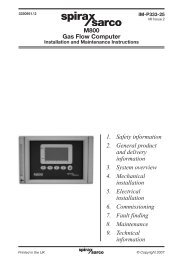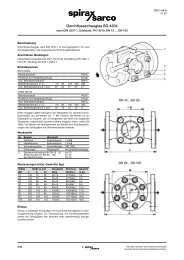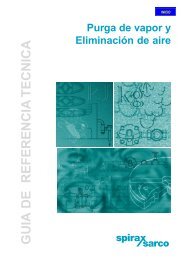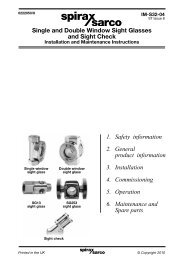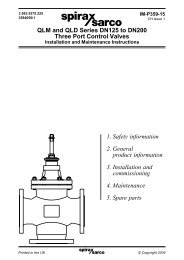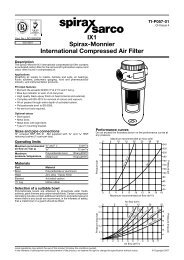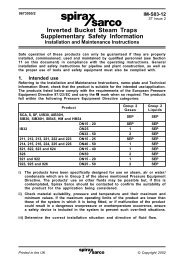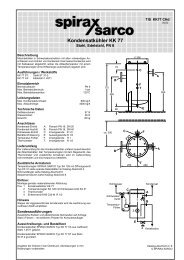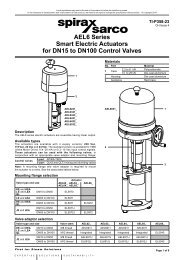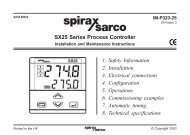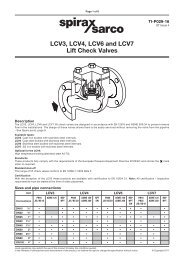2000 Hook-up Book - Spirax Sarco
2000 Hook-up Book - Spirax Sarco
2000 Hook-up Book - Spirax Sarco
Create successful ePaper yourself
Turn your PDF publications into a flip-book with our unique Google optimized e-Paper software.
SYSTEM DESIGN<br />
34<br />
Draining Temperature Controlled Steam Equipment<br />
An example plot is shown on<br />
Fig. 46 for a coil where air is heated<br />
to 80°F and the trap must<br />
discharge against back pressure.<br />
Step 1. The system is designed for<br />
100% load when air enters at 0°F<br />
(T 1) and there is 0% load when air<br />
enters at 80°F (T 2). Draw line<br />
(T 1/T2) connecting these points.<br />
Step 2. At maximum load, the<br />
arithmetic mean air temperature<br />
(MT) is 40°F. Locate (MT) on line<br />
(T 1/T 2), extend horizontally to 0%<br />
load, and identify as (MT 1).<br />
Step 3. Allowing for pressure<br />
drop, the control valve has been<br />
sized to s<strong>up</strong>ply 25 psig steam to<br />
the coil at 100% load. This pressure<br />
is (P 1) and has a steam<br />
temperature of 267°F. Mark (P 1)<br />
and draw line (P 1/MT 1).<br />
Line (P 1/MT 1) approximates the<br />
steam s<strong>up</strong>ply at any load condition<br />
and the coil pressure is below<br />
atmospheric when it drops below<br />
the heavy line at 212°F. In a gravity<br />
system with sub-atmospheric<br />
Design MTD<br />
Stall MTD<br />
Temperature °F<br />
R 2<br />
conditions, a vacuum breaker and<br />
hydraulic pressure due to condensate<br />
will prevent stall and allow<br />
the trap to drain the coil.<br />
Step 4. In many systems, the trap<br />
does not discharge freely to<br />
atmosphere and in our example,<br />
total back pressure on the trap is<br />
15 psig, drawn as horizontal dotted<br />
line (P 2). Coil pressure equals<br />
back pressure at the intersection<br />
of (P 2) with (P 1/MT 1) which when<br />
dropped vertically downward to<br />
(R 1) occurs at 93% load. At less<br />
than this load, the required trap<br />
differential is eliminated, the system<br />
“stalls,” and the coil begins to<br />
waterlog. In our air heating coil<br />
the air flows at a constant rate<br />
and extending the air temperature<br />
intersection horizontally to (R 2),<br />
stall occurs when the incoming air<br />
is 6°F or more.<br />
The same procedure applies<br />
to a heat exchanger although the<br />
example temperature is not a<br />
common one. If the stall chart<br />
Figure 46: Air Make-<strong>up</strong> Coil Stall Chart<br />
400<br />
380<br />
360<br />
340<br />
320<br />
300<br />
280<br />
260<br />
240<br />
220<br />
200<br />
180<br />
160<br />
140<br />
120<br />
100<br />
80<br />
60<br />
40<br />
20<br />
P 1<br />
MT<br />
0<br />
T1 100 90 80 70 60 50 40 30 20 10 0<br />
Percentage Load<br />
R1 P 2<br />
235<br />
180<br />
140<br />
105<br />
75<br />
55<br />
34<br />
20<br />
10<br />
3<br />
0<br />
5"<br />
10"<br />
15"<br />
20"<br />
25"<br />
T 2<br />
MT 1<br />
Inches Vacuum Pressure psig<br />
example represented a heat<br />
exchanger where the liquid was to<br />
be heated through a constant temperature<br />
rise from 0 to 80°F, but at<br />
a flow rate that varies, stall would<br />
still occur below 93% load. In this<br />
instance, if 100% load represents<br />
a 50 GPM exchanger, the system<br />
would stall when the demand was<br />
46.5 GPM (50 x .93) or less.<br />
Draining Equipment Under<br />
“Stall” Conditions<br />
“System stall” is lack of positive<br />
differential across the steam trap<br />
and temperature controlled<br />
equipment will always be subject<br />
to this problem when the trap<br />
must operate against back pressure.<br />
Under these conditions, a<br />
vacuum breaker is ineffective<br />
because “stall” always occurs<br />
above atmospheric pressure.<br />
Even when steam is s<strong>up</strong>plied at a<br />
constant pressure or flow to<br />
“batch” type equipment, stall can<br />
occur for some period of time on<br />
start<strong>up</strong> when the steam condenses<br />
quickly and the pressure drops<br />
below the required differential.<br />
What happens when the system<br />
stalls is that the effective coil<br />
area (“UA” in the formula) drops as<br />
the steam chamber floods and<br />
heat transfer is reduced until the<br />
control valve responds to deliver an<br />
excessive s<strong>up</strong>ply of steam to the<br />
coil. This results in a “hunting system”<br />
with fluctuating temperatures<br />
and hammering coils as the relatively<br />
cooler condensate<br />
alternately backs <strong>up</strong>, then at least<br />
some portion is forced through the<br />
trap.<br />
The solution to all system stall<br />
problems is to make condensate<br />
drain by gravity. Atmospheric systems<br />
tend to operate more<br />
predictably and are generally easier<br />
to control but major heating<br />
equipment is usually not drained<br />
into an atmospheric return<br />
because of the large amount of<br />
energy that is lost from the vent. In<br />
many process plants, venting<br />
vapors of any type is discouraged<br />
and a “closed loop” system is not<br />
only required but is less subject to<br />
oxygen corrosion problems.



